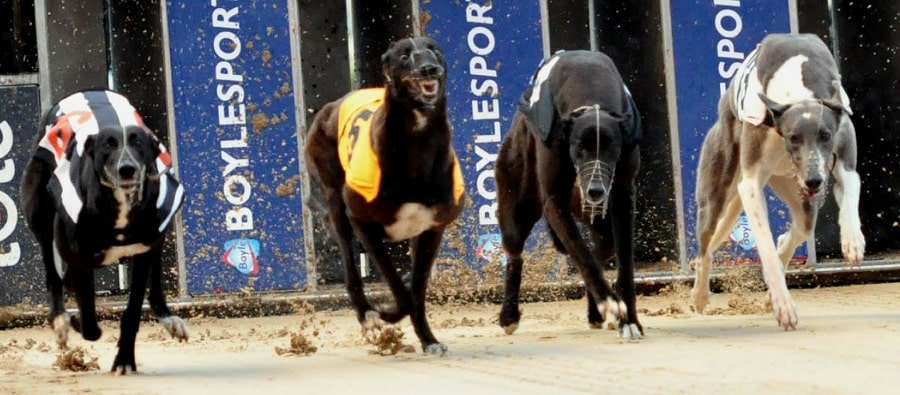- Code of Practice
- GRI Advice regarding Export of Greyhounds
- Welfare Legislation
- Irish Retired Greyhound Trust
- Track Welfare
- Press & Media
- Stolen or Missing Greyhounds
- Welfare Penalties
- Welfare Inspections/Fines
- Caring for the Greyhound in Hot Weather
- Greyhound Careline
- Injury at Tracks Recovery Scheme
- Greyhound Care Fund
- Greyhound Dental Health
RCÉ / GRI Notice
Caring for the Greyhound in Hot Weather
General:
Hot weather can cause ‘Heat Stress’ in greyhounds. High humidity will increase the risk. A greyhound loses heat mainly by evaporating water from moisture from the lungs, airway and mouth by panting. Heat loss also occurs to a much lesser extent via the skin and through the excretion of urine , faeces and saliva.
These methods of controlling body temperatures in dogs are normally very efficient but if outside temperatures are too high then the main heat control mechanism of panting is not sufficient to keep the dog’s body temperature within the normal range 38-39* Cent.
As detailed in GRI’s Code of Practice in the Care & Welfare of the Greyhound, the owner/trainer of a greyhound is responsible for the animal’s welfare. The principles which underpin best welfare practice apply at all times but some take on a greater urgency during hot weather, these principles being ‘Freedom from thirst, discomfort, pain, distress and the freedom to express normal behaviour.’
MINIMISING THE POSSIBILITY OF HEAT STRESS.
AT HOME
- Always ensure your dog has access to fresh drinking water. It is best to fix the water container to a fence or kennel wall at a height that allows the dog to drink but not paddle/splash in it. Ice blocks may be added to drinking bowls.
- Note that in controlling their body temperature by panting, greyhounds lose water, not electrolytes. Giving additional electrolytes in water/food to a greyhound that is dehydrating through heat stress is dangerous as it creates some metabolic imbalances (potassium and sodium salt levels) which have the potential to compromise the function of vital organs like heart, kidney and brain.
- Ensure there is as much air movement through your kennels as is possible.
- Ensure that the kennels are adequately shaded at all times of the day, using a curtain/cloth shade.
- Consider leaving wet towels/blankets in kennels for dogs to lie on.
- Where possible, cool the roofs of kennels by hosing them.
- Allow dogs to have access to sheltered areas in paddocks/runs.
- Exercise dogs in the cool of the morning or late evenings.
- Avoid disrupting the dogs’ normal routine as this may cause distress.
- Check greyhounds regularly during the day, paying particular attention to any new intakes or apprehensive greyhounds.
Keep your greyhound stress-free in hot weather. Think ---
VENTILATION, WATER, SHADE.
TRAVELLING.
Transporting a greyhound during hot weather can be high risk unless the vehicle is air conditioned or can be adequately ventilated.
- Keep trailer/vehicle open in a cool shady area before travelling
- Ensure greyhound is well hydrated before travelling.
- Air-conditioned (best) or well-ventilated vehicle.
- Keep travel time to a minimum.
- Break the journey to check your dogs.
- Park vehicle in the shade. Never leave dogs in vehicles parked in the sun.
- Carry sufficient water and ice, allowing for any delays.
AT THE TRACK...
On arrival at a track, remove greyhounds immediately from the vehicle. Give immediate access to water. It may be advisable sponge/spray the dog with cool water around the head, neck and underneath the front and back legs. Report any signs of heat stress to the stewards/vet on duty. Signs of heat stress can vary from excessive panting, drooling, staggering/cramping to seizure and collapse. Do not give oral electrolytes to a heat-stressed dog.
- Dogs should be weighed in and placed in the kennels as soon as is practically possible.
- Where possible, tracks without air conditioners should maximise airflow through kennels using large fans.
- The time spent parading or at presentations should be minimised.
- No presentation should be made before a dog is allowed to drink and cool down.
- Track vets and stewards should be extra vigilant during hot spells when monitoring dogs for signs of heat stress.
POST RACE TRAVEL.
Owners/trainers should ensure that after racing, dogs are immediately cooled down (hosed) , given access to drinking water and where possible placed in a cool kennel, before travelling home from the track. Be extra vigilant and prevent the onset of heat stress by doing regular checks on dogs and breaking the journey. On arrival at home, hose the dog as necessary to cool him. Provide fresh cold water to drink and be satisfied that when the dog is placed in the home kennel that he is not showing any of the signs of heat stress.
